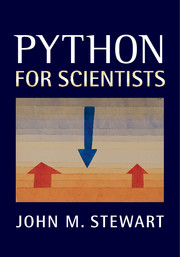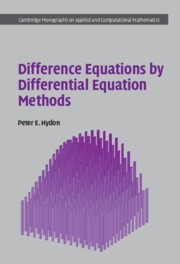Refine search
Actions for selected content:
2540 results in Computational Science
8 - MuPAD
- from Practice Set B - Math, Graphics, and Programming
-
- Book:
- A Guide to MATLAB®
- Published online:
- 28 May 2018
- Print publication:
- 21 August 2014, pp 111-120
-
- Chapter
- Export citation
6 - MATLAB Programming
- from Practice Set A - Algebra and Arithmetic
-
- Book:
- A Guide to MATLAB®
- Published online:
- 28 May 2018
- Print publication:
- 21 August 2014, pp 77-94
-
- Chapter
- Export citation
Frontmatter
-
- Book:
- A Guide to MATLAB®
- Published online:
- 28 May 2018
- Print publication:
- 21 August 2014, pp i-iv
-
- Chapter
- Export citation
Practice Set B - Math, Graphics, and Programming
-
- Book:
- A Guide to MATLAB®
- Published online:
- 28 May 2018
- Print publication:
- 21 August 2014, pp 105-110
-
- Chapter
- Export citation
12 - Troubleshooting
- from Practice Set C - Developing Your MATLAB Skills
-
- Book:
- A Guide to MATLAB®
- Published online:
- 28 May 2018
- Print publication:
- 21 August 2014, pp 215-228
-
- Chapter
- Export citation
References
-
- Book:
- Difference Equations by Differential Equation Methods
- Published online:
- 05 August 2014
- Print publication:
- 07 August 2014, pp 198-201
-
- Chapter
- Export citation
Dedication
-
- Book:
- Difference Equations by Differential Equation Methods
- Published online:
- 05 August 2014
- Print publication:
- 07 August 2014, pp v-vi
-
- Chapter
- Export citation
6 - Conservation laws
-
- Book:
- Difference Equations by Differential Equation Methods
- Published online:
- 05 August 2014
- Print publication:
- 07 August 2014, pp 165-197
-
- Chapter
- Export citation
2 - Simple symmetry methods for OΔEs
-
- Book:
- Difference Equations by Differential Equation Methods
- Published online:
- 05 August 2014
- Print publication:
- 07 August 2014, pp 35-75
-
- Chapter
- Export citation
4 - Lattice transformations
-
- Book:
- Difference Equations by Differential Equation Methods
- Published online:
- 05 August 2014
- Print publication:
- 07 August 2014, pp 108-137
-
- Chapter
- Export citation
Frontmatter
-
- Book:
- Difference Equations by Differential Equation Methods
- Published online:
- 05 August 2014
- Print publication:
- 07 August 2014, pp i-iv
-
- Chapter
- Export citation
Contents
-
- Book:
- Difference Equations by Differential Equation Methods
- Published online:
- 05 August 2014
- Print publication:
- 07 August 2014, pp vii-x
-
- Chapter
- Export citation
3 - Extensions of basic symmetry methods
-
- Book:
- Difference Equations by Differential Equation Methods
- Published online:
- 05 August 2014
- Print publication:
- 07 August 2014, pp 76-107
-
- Chapter
- Export citation
Preface
-
- Book:
- Difference Equations by Differential Equation Methods
- Published online:
- 05 August 2014
- Print publication:
- 07 August 2014, pp xi-xiv
-
- Chapter
- Export citation
5 - Solution methods for PΔEs
-
- Book:
- Difference Equations by Differential Equation Methods
- Published online:
- 05 August 2014
- Print publication:
- 07 August 2014, pp 138-164
-
- Chapter
- Export citation
1 - Elementary methods for linear OΔEs
-
- Book:
- Difference Equations by Differential Equation Methods
- Published online:
- 05 August 2014
- Print publication:
- 07 August 2014, pp 1-34
-
- Chapter
- Export citation
Acknowledgements
-
- Book:
- Difference Equations by Differential Equation Methods
- Published online:
- 05 August 2014
- Print publication:
- 07 August 2014, pp xv-xvi
-
- Chapter
- Export citation
Index
-
- Book:
- Difference Equations by Differential Equation Methods
- Published online:
- 05 August 2014
- Print publication:
- 07 August 2014, pp 202-206
-
- Chapter
- Export citation

Python for Scientists
-
- Published online:
- 05 August 2014
- Print publication:
- 10 July 2014

Difference Equations by Differential Equation Methods
-
- Published online:
- 05 August 2014
- Print publication:
- 07 August 2014
